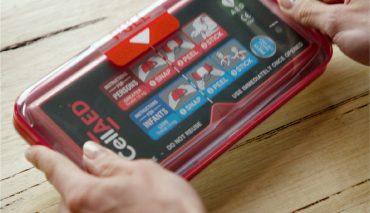Taking luck out of the survival equation: Dr Steven Brooks
As a long-time advocate for better access to defibrillation as a measure against sudden cardiac death, Dr Steven Brooks understands the problem better than most.
A practicing emergency physician as well as a resuscitation science investigator, Dr Brooks frequently experiences first-hand the high toll associated with sudden cardiac arrest. He is a vocal proponent for raising awareness of sudden cardiac arrest, increasing CPR literacy, and improving community and household access to lifesaving defibrillation in the way of AEDs (automated external defibrillators).
In this interview, Dr Brooks explains why he has taken on the role of Rapid Response Revival’s Chief Medical Officer, and the opportunity CellAED® represents to save more lives from sudden cardiac arrest.
You’ve dedicated much of your career to resuscitation science. Why?
“The impact of sudden cardiac arrest is a health crisis. It’s a crisis the world’s best medical and policy minds have been working on for a long time, but several key challenges have been very difficult to address.
“A key challenge is that the response to sudden cardiac arrest needs to be immediate. Unfortunately, simply calling emergency services and waiting for paramedics to arrive is not enough. To have any reasonable chance at survival, those who experience cardiac arrest rely on bystanders to start CPR immediately and use an AED.
“Out-of-hospital cardiac arrest kills quickly, and in huge volumes. The heart has stopped beating effectively during cardiac arrest – and for every minute that nothing is done, a person’s chances of survival decrease by approximately 10 per cent.
“Right now, surviving out-of-hospital cardiac arrest is a question of luck: was the event witnessed, did the witness recognise what is happening and know how to call for help, did they know CPR (cardiopulmonary resuscitation), and was there an AED (automated external defibrillator) nearby?
“I’ve been driven by the idea that survival after cardiac arrest shouldn’t be a question of luck. For a very long time, the world’s resuscitation science community has been searching for ways to take luck out of the survival equation by designing strategies that can get CPR and an AED to the patient as quickly as possible.”
When you first saw CellAED®, what did you think?
“I saw what the resuscitation science community has been waiting for, for decades.
“My first reaction was scepticism – but I also knew that if CellAED® worked, then I would need to be involved in some way.
“It addresses the biggest barriers to improving access to life-saving defibrillation where out-of-hospital cardiac arrests are most likely to occur. Here is a miniaturised, easy-to-use defibrillator that is a fraction of the cost of conventional AEDs.
“Even after years of searching for something like this, it still seemed like science fiction when I first encountered it. After initial discussions with the company, I came to realise that CellAED® was real, and I was looking at a piece of technology that was going to change everything.”
RELATED ARTICLE: The future of defibrillation isn’t science fiction
Were you surprised where CellAED® came from?
“It didn’t surprise me at all that CellAED® was born out of a cardiac arrest survivor story. So many of the most passionate campaigners and the most effective innovators in this space are driven by personal experience.
“That this paradigm shift in defibrillation would come from the grass roots, and not an established AED manufacturer, makes sense. Survivors and the families of those who haven’t survived are the ones with the real motivation to make change happen.”
Why do you think CellAED® will be an effective solution?
“Sudden cardiac arrest kills in minutes. The most effective method of saving a life from sudden cardiac arrest is with a defibrillator – and yet, only 3 per cent of all out-of-hospital cardiac arrest patients have an AED used before paramedics arrive.
“The main issue is that there are too few defibrillators in our communities, and those out there are not positioned in places where cardiac arrest is most likely to occur. Conventional AEDs are too expensive and too bulky to be a realistic option for most individuals to carry with them or purchase for their homes.
“AEDs are generally purchased by businesses, governments or community organisations for placement in public areas. The problem is that more than 70 per cent of cardiac arrests occur in the home where access to conventional AEDs is non-existent.
“CellAED® can change that. It represents an opportunity for life-saving defibrillation to be universally available, to be where most out-of-hospital cardiac arrests occur – homes and workplaces. If there is a CellAED® nearby, chances of surviving sudden cardiac arrest significantly improve.”
What makes CellAED® different?
“Defibrillation is not new. AEDs have been available in public spaces for decades. It is a proven fact that early application of a defibrillator gives a sudden cardiac arrest patient their best chance of survival.
“CellAED® has improved on conventional AED design in many ways, such as its unique connectivity and ‘smart’ functionality, but the real genius of CellAED® is its accessibility.
“CellAED® opens up the possibility of personal access defibrillation at home and for individuals to carry with them on their person. However, it also provides an opportunity to improve public access defibrillation in public spaces as well.
“With CellAED®, the manager of a public access defibrillation network will be able to increase the number of available AEDs by up to 10 times for the same cost of establishing and maintaining a network of conventional AEDs today.
“By increasing the number of available devices, the chance that anyone experiencing cardiac arrest in that space will multiply, while the delay to retrieving the nearest device will decrease. When seconds count, this will translate into more lives saved.”
Why take on the Chief Medical Officer role?
“As a researcher, I’ve always guarded my independence from industry very carefully. Keeping free from potential conflicts of interest is important for researchers striving to produce results free from bias.
“However, the source of my motivation for this area of science has always been to try and increase the number of people who have the advantage of bystander CPR and early defibrillation. We know these devices work to save lives, we just need to organise our approach to make this happen.
“I’ve come to realise that the integration of key technologies is a critical piece of the solution when we are talking about sudden cardiac arrest. We can’t do this without industry and technology.
“The truth is, I believe CellAED® is a game changer. After learning about CellAED® and the opportunities it presents, I realised that passing up the chance to become part of the Rapid Response Revival team would be a mistake.
“I took on this role because I think CellAED® should profoundly change the way we address sudden cardiac arrest in our communities.”
“I am convinced that CellAED® is the part of the puzzle we have been missing while trying to solve the problem of public access defibrillation. If we do a good job of deploying CellAED® into our communities globally, this device will save many, many lives.”
RELATED ARTICLE: Why we invented CellAED®
Why are you so confident CellAED® will improve bystander response?
“Although conventional AEDs are designed for use by people with little to no training, CellAED® takes this much further.
“The fundamental design of CellAED® is simple, with large pictogram instructions on how to snap, peel and stick the device. There’s no assembly required. And of course, the major advantage is that we have the potential to ensure there are many more CellAEDs® in our homes and communities compared to conventional AED networks.
“To survive an out-of-hospital cardiac arrest, you need a bystander with the right skills, tools and support to take immediate action. CellAED® makes it much, much easier for the bystander to do that.”
You’re just getting started in this role. What’s your first order of business?
“My immediate role can best be summarised in two words – encouraging adoption. I’m sure when they see it, CellAED® will be adopted by the world’s first-aiders, doctors, physicians, emergency responders – and ultimately, households.
“I’m here to help make that happen, to take luck out of the survival equation, and save lives.”



